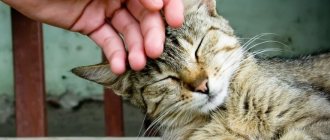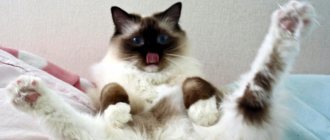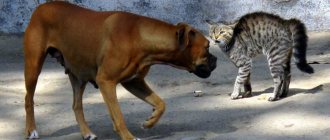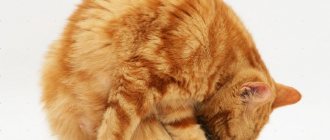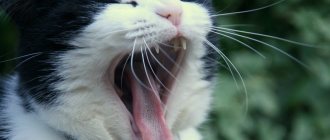Which organs are responsible for a cat's rumbling?
Sometimes you may come across the statement that if a cat purrs, it does so either through its nose or through its throat. This is not entirely true: the brain is the main organ that causes cats to purr. Of course, the sounds themselves are produced by the vocal cords, which vibrate due to the movement of the vocal muscles located in the larynx. However, without a corresponding signal from the brain, the muscles will not begin to move on their own. That's why cats never rumble or purr for no reason; there must be something that spurs their brain to reproduce the command to “sing,” for example, seeing a sparrow outside the window or inhaling the aroma of fried fish.
Rumbling mechanism
Scientists don’t know exactly how cats purr, but there are interesting assumptions. The vocal cords are responsible for the sound, and the origin of the vibration emanating from the animal during this process has several theories.
The most common theory focuses on the hyoid bones. In wild animals this bone is rectangular in shape, in domestic animals it is triangular. This explains the reason that wild felines rarely purr, but domestic ones, on the contrary, often purr.
Hyoid bones of a dog (left) and a cat (right)
Sound passes through the oral and nasal cavities. As for vibrations, it is known for sure that they arise from brain signals. When an animal experiences emotions (negative or positive), the brain sends neurons to that organ, which produces a rumbling sound.
It is also a popular assumption that the muscles behind the vocal cords are responsible for rumbling. When these muscles contract, the hyoid bones begin to vibrate.
According to another version, the animal’s lungs are used in the process of rumbling, namely the intercostal and diaphragmatic muscles. During breathing, they can create various sound vibrations.
This theory is not particularly widespread, since during inhalation and exhalation the intensity of the rumbling does not change in any way. The false cords located above the vocal cords can also rumble. Outwardly, they resemble elastic membranes.
Interesting: Why are there fewer cat breeds than dog breeds?
Rumbling is a sign of peace and more
Many of us believe that since a cat purrs, then everything is fine. But, unfortunately, such uterine sounds are not always a sign of pleasure or satiety. Let's see in what cases you can hear a cat purring:
Photo: Scottish Fold kitten | Dreamstime.com
- Possessive rumbling
- if a cat tramples with its front paws and purrs, then one can suspect that this is how the animal marks the owner in a unique way, making it clear to the person that the head of the house is His Majesty the Cat; - Rumbling as a sign of pleasure from communicating with a person
- almost all cats purr when they are petted, but suddenly stop doing this when they get tired of the owner’s touch; - Purring as an attempt to help oneself
- sometimes a cat purrs like a tractor if something hurts. So, a pet may well purr, licking its wounds after a collision with a neighbor’s dog. A cat can purr during a fracture caused by a fall from a height, during childbirth, or during an exacerbation of any chronic illness. It's sad, but sometimes animals purr even before they die, perhaps trying to calm themselves down; - Rumbling as a signal of calm for kittens
- if you watch a nursing mother and her cubs, you will notice that the cat moves her paws and purrs when the kittens suckle her milk. Rumbling at such moments is necessary for babies to feel safe; - Rumbling as a sign of a peaceful attitude
- sometimes cats can purr in front of each other. They do this in order to demonstrate goodwill to other individuals; - Rumbling as an accompaniment to sweet slumber
- cats cannot purr in their sleep, but during rest and slumber they can purr quite well. Especially in situations where a delicious lunch has been eaten and there is no threat around; - Rumbling as an anticipation of something good
- our pets begin to rumble when they anticipate that something pleasant or tasty is waiting for them. So, a cat can easily start “singing” loudly if he sees that the owner is sitting down in a chair (it’s time not just to watch TV, but also to pet the cat!). Or you can hear the purring of an animal that has seen and felt that the owner has begun to cut up fish or meat in the kitchen; - Rumbling as an attempt to cure the owner
- many owners know that cats can predict a person’s mood, and also feel when a person is not feeling well. For example, if a cat owner has a heartache, then the pet can easily lie down on the cat’s chest and begin to purr and rumble. This is how the animal tries to help the owner cope with pain.
So, there are many reasons for a cat’s purring. But how can you recognize when an animal makes such sounds from pleasure and when from pain? It turns out that cats always purr in different ways. Thus, a loud rumbling at a frequency of about 50 Hz may indicate that the pussy is trying to cope with the pain of a fracture or dislocation, and a rumbling at a frequency of 100 Hz or more may indicate that the animal is suffering from some kind of chronic disease.
In addition, the vigilant owner will be able to notice the state of ill health by other alarming symptoms in addition to loud rumbling: elevated temperature, upset stool, vomiting, limping, and so on. And if an animal purrs quietly at a low frequency of up to 35 Hz, closing its eyes and tucking its paws under itself, then it is probably in calmness and in a good mood.
Why do cats purr?
Many people believe that when cats experience positive emotions, they begin to purr. This is not an entirely true statement, since rumbling can also be caused by negative emotions.
For each feline representative, this process has an individual character. You can only figure out what emotions your pet is experiencing over time by monitoring the volume, frequency and duration of the rumbling.
Cats purr to show different emotions
Cats can make characteristic sounds, but in a mild form, already on the second day of their birth. Nature created this mechanism so that babies could “show” their mother that they feel good and are full. The mother cat also makes soft purring sounds to confirm that her offspring are safe.
Positive emotions that provoke purring can be different. An animal can greet its owner, communicate, lie down to rest, ask for something, show interest, gratitude, etc.
Interesting fact: there is a theory that purring allows a cat to relax. At the same time, the resulting vibrations affect her musculoskeletal system.
Purring can occur when a cat is stressed. Vibrations normalize pulse and blood pressure. This mechanism is also triggered when the animal is sick - rumbling speeds up metabolism and acts as a pain reliever. The cat may not like the way its owner strokes it, or it may not “see eye to eye” with its opponent.
Cat purring - real sound therapy
We have already mentioned that cats often lie down on the owner’s sore spot and begin to purr. An animal can, for example, lie on the owner’s legs if they are “whining” about the weather. Or even lie on your head when the owner is tormented by a migraine. What does this mean, can pets really heal? It turns out that the purring of cats is therapeutic sound therapy.
Photo: Scottish Fold kitten | Dreamstime.com
A measured, quiet sound calms frayed nerves no worse than the sound of rain or the sound of a babbling stream. Felinologists believe that cats, with the help of special rumbling sounds, can treat the following ailments:
- Bone fractures, joint and muscle pain;
- Nervous disorders (depression, stress);
- Reduced immunity;
- Arterial hypertension;
- Diseases of the heart and blood vessels;
- Various inflammatory processes;
- Diseases of the stomach and/or intestines;
- Respiratory ailments.
Even though the sounds of rumbling help relieve, for example, joint pain or lower blood pressure, such sound therapy cannot be considered a full-fledged treatment; you will still need the help of a doctor. However, a cat's purring fights well against the same fatigue and nervousness.
The benefits of purring for humans and cats
As mentioned earlier, many zoologists attribute medicinal properties to the specific sounds of cats. Through observation and research, it was discovered that the vibrations emitted by pets can indeed bring considerable benefits.
There is even a separate branch of medicine that practices treatment by communicating with cats, feline therapy. The purring of these pets with a frequency ranging from 20 to 140 Hz has a beneficial effect on health.
A statistical study revealed that cat owners:
- tolerated stressful situations more easily;
- did not suffer from high blood pressure and pulse rate;
- were more communicative;
- were less likely to become depressed;
- were less likely to have a heart attack or stroke;
- cope more easily with various types of shortness of breath and breathing problems;
- suffered less from kidney disease;
- tolerated loneliness and change of environment better;
- more than 20% less likely to seek medical help.
These mysterious pets are able to relieve various types of pain (headache, joint, nervous or bone pain). They try to lie down on the problem area and start purring.
Cats also improve heart health and can heal spinal diseases (osteochondrosis and radiculitis). For this, the cat collar method is used. The animal lies around the neck for several minutes a day, warming it and purring.
Photo: the purring of a cat has a beneficial effect on the body
A cat's purring has the ability to strengthen bones, treat fractures and bruises, soft tissue injuries, calm (reduce stress), reduce pain and fight viral diseases.
This list is truly impressive! That is why these animals almost never suffer from bone and heart diseases.
By purring, a cat ensures a long life. The vibration spreads throughout the animal’s body, renewing organs and stimulating muscles. Such self-medication allows these mystical pets to remain very active even in quite advanced years.
For you, a cat's loud rumbling, for which there is no apparent reason, can be a signal that your pet is sick or injured.
Big cats purr too
So, cats purr for many reasons. Can their large wild counterparts make similar sounds? Or is rumbling a privilege only for domestic cats? The answer is: wild cats can also purr: lions and tigers, leopards and pumas, lynxes, jaguars and other representatives of the cat family. However, it is important to note that the larger the cat, the louder and more menacing its purring sounds, since the cartilage of their larynx is too hard to reproduce such measured sounds that an ordinary cat is capable of “singing.” For example, in the same lions, the peaceful rumbling sounds more like a roar.
Are only cats able to purr?
It is widely believed that purring is a privilege of the feline family. Indeed, each of its members, regardless of size, can make similar sounds, but in large representatives they are more like a roar and roar.
However, there are many species in the animal kingdom that have a similar ability. For example, species related to cats are cat-like hyenas and civets: mongooses, genets, civets. In a good mood, foxes and badgers, guinea pigs and squirrels purr while eating. Gorillas and sometimes even elephants rumble quite loudly.
Cat purring: what does it mean?
We can generally think of purrs as the cat's equivalent of the human smile: they have the same ethological significance. This is a means of communication.
We may smile because we are happy, but we may smile the same way in difficult or awkward situations, or to show that we are supportive or do not have aggressive intentions.
But a wounded, sick or suffering cat also purrs. Likewise, a cat that is giving birth or nursing may purr for comfort.
Other low sounds are used to ask for something, to greet, to mark recognition or approval, such as a short, isolated whisper that quickly falls off in intonation.
© shutterstock
How does purring affect a cat's body?
Sometimes a healthy cat purrs next to a sick one, and this happens for a reason. From the outside it may seem that a purring cat is happy with the presence of a relative, but British scientists have proposed a version of purr therapy. Firstly, the monotonous sound is soothing. Secondly, the vibration produced by purring is similar to a massage. In this case, we are talking about a therapeutic effect on internal organs. In addition, purring increases the cat's vitality and improves its mood.
By purring, a cat can “treat” not only itself, but also its relatives
Indeed, if you watch a cat, you can see how it licks its wound and purrs. Saliva has a disinfecting effect, and purring acts as an ultrasound and anti-stress. Purring cats are healthier, calmer and friendlier.
Video: purring - a lullaby for a kitten
Why do cats purr?
The issue of cats purring is much more complex and deeper than it seems at first glance. Understanding why your pet purrs will be a big step towards predicting his mood, meeting his needs and, above all, living a harmonious life with him. Below are some of the reasons why cats purr.
Reason #1: Purring as a means of communication
Cats communicate primarily through movement, but that doesn't mean they can't communicate through sounds. However, unlike humans, whose speech has evolved over many years, cats have to make do with just a few sounds they can produce - and purring is one of them.
One of the reasons your pet purrs is communication.
Did you know that cats can make many different purring sounds? For example, if your pet purrs due to hunger, then the purring is accompanied by a whimper, similar to the cry of a child. Sounds like these are hard to ignore. The idea is to appeal to the parental instinct in you and draw attention to the hungry animal.
Cats also purr to communicate pain, boredom, and other feelings. Usually, the expression of feelings through purring is accompanied by other signs. Knowing how a cat purrs when it is healthy will help you quickly understand when something is wrong with your pet.
Reason #2: the bond between a mother and her kittens
A nursing mother is known to purr to communicate with her kittens. She uses purring as a lullaby to calm babies. This works much the same way as rocking or humming for babies.
Babies communicate with their mother by purring
Kittens begin to purr a few days after birth. At this time, their auditory and visual abilities are not yet fully functional. For young kittens, purring is a way of reassuring their mother that they are okay. Babies also purr to call out to their mother when they feel she is not around.
Reason #3: Manifesting Happiness and Satisfaction
A cat purrs when it is happy and content. This is due to her good health and satiety. A cat will purr while eating, and kittens will purr when their mother licks them. Tickling or a light massage also makes cats purr with pleasure.
A cat purrs when it is happy and content
These manifestations of feline pleasure can make us, their owners, happier. Cat purring is in the frequency range that relaxes people. It has been scientifically proven that cat caresses and purring vibrations have a calming effect on humans. Reducing tension correspondingly lowers blood pressure levels. This explains the benefits of cat companionship for your health.
Reason #4: Pain relief
Do you think cats only purr when they are happy and healthy? It is not always so. You should not ignore the signals that your pet gives, because the cause of purring may be illness. Purring can also be caused by your cat trying to relieve your pain.
Cats purr when they seek relief from pain.
- Cats tend to purr during labor. Purring triggers the release of endorphins in the animal's brain centers. This “happy hormone” acts as a powerful natural pain reliever and helps her relax. Purring is also an alternative to the agonizing screams that would attract predators in the wild.
- In addition, cats can purr in a range that helps speed up the healing of fractures and torn ligaments. These frequencies can also soothe sore muscles. The need for such skills is due to the fact that these animals sleep on average 16 hours a day. This prolonged inactivity contributes to decreased bone density and muscle strength. Seals counteract these processes by purring. This can also speed up a person’s healing. The purring frequencies are believed to be in the same range as the frequencies used in ultrasound devices to speed the healing of bone fractures in humans.
- If you have trouble breathing, try to breathe in sync with your cat's purring. The purring process imitates the normal dynamics of human breathing - thus the cat helps restore the normal rhythm of inhalation and exhalation.
However, don't try to imitate your cat's purring. If you have tried this before, then you must have already realized that it is impossible. You probably experienced shortness of breath after the first few seconds of trying in vain. The question arises: how do cats do this?
Causes
The first reason is pleasure. Kittens purr from warmth and satiety, adult cats purr from the affection of their owner. Animals show it not only by sound, but also, for example, by releasing their claws.
In addition, there are a number of other factors that can trigger purring:
- Demand for attention.
- Request for food.
- Relieving stress and pain, for example, during childbirth or severe wounds, fear.
- Expression of gratitude.
- Acquaintance.
- The joy of hunting.
Mr. Cat recommends: interesting facts
Purring is a process unique to the animal world. But among the purring ones there are their own records:
- The volume of the rumbling varies in the range from 16 to 100 dts.
- The English cat Merlin purrs four times louder than an ordinary pet. The sound is so loud that it drowns out a running hair dryer. Eyewitnesses compare the cat's purring to the sound of a landing plane.
- The kitten makes its first “murr” at the age of two days.
- The most “purring” country in the world is Australia, where there is a cat for every resident.
Purring as communication
Depending on the timbre and volume, the purring of one cat may indicate a demonstration of a social role in front of another. A quiet purr speaks of friendly and peaceful thoughts: for example, a cat thus shows the cat its defenselessness. Loud is a manifestation of dominance.
Many owners note that if someone in the house is sick, the cat will certainly purr supportively over the sick person.
A person is perceived by a pet as an equal member of the pack. A purring pet shows the household its affection, gratitude, or asks for affection. If a cat with a raised tail purrs loudly and sparkles its eyes at a guest or a new thing, this means a demonstration of hostility.
